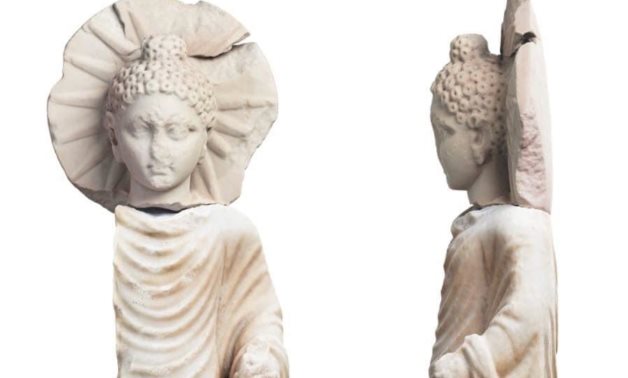
File: The newly uncovered Buddha statue.
The American-Polish archaeological mission discovered in the forecourt of a temple in Berenike a statue of the Buddha made from marble.
The American-Polish archaeological mission uncovered the Buddha statue while excavating a temple in Berenike at the Red Sea that is dating back to the main early Roman period and was dedicated to the Goddess Isis.
Mostafa Waziry, Secretary General of the Supreme Council of Antiquities, recounted that the Buddha statue proves the existence of trade between Egypt and India during the Roman Empire.
Waziry further explained that in the ancient world Egypt was located at the centre of a trade route that connected the Roman Empire with many countries.
The Secretary General of the Supreme Council of Antiquities explained that a number of Roman-era harbours on Egypt's Red Sea coast were involved in commerce operations, the most important of which was Berenike.
Waziry added that at that time ships from India used to arrive at Berenike with Indian products including pepper, semi-precious stones, textiles and ivory.
According to Waziry other ships then transported the products to Alexandria and from Alexandria to the rest of the Roman Empire.
Mariusz Gwiazda, head of the Polish side of the mission, announced that the newly uncovered statue is 71-centimetre-high and depicts the Buddha standing and holding part of his clothing in his left hand.
Gwiazda further explained that a lotus flower stands beside Buddha and a halo with sunrays surrounds his head to reflect his brilliant mind.
The head of the Polish side of the mission said that the workmanship of the newly uncovered Buddha statue is exquisite, adding that it is the strongest evidence that Buddhism was excavated in Egypt long ago.
“The newly uncovered Buddha statue was made from stone probably quarried from the region just south of Istanbul, it was sculpted at Berenike and dedicated to the temple by one or more Indian merchants"
Gwiazda added.
Steven Sidebotham, director of the American side of the mission, announced that archaeologists also discovered an inscription in Sanskrit dating to the Roman emperor Philip the Arab.
Sidebotham further explained that this inscription most probably dates back to a different era from that of the statue of the Buddha which dates back to a much earlier era.
The mission also discovered other inscriptions in Greek in the same temple. These inscriptions belong to the early first century CE to 305 CE.
The mission also managed to discover two second-century CE coins that date back to the central Indian Kingdom of the Satavahanas inside the temple.
Comments
Leave a Comment